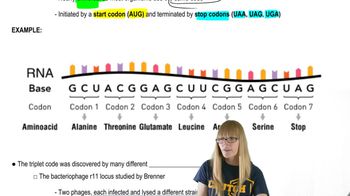The effect of base-pair substitution mutations on protein function varies widely from no detectable effect to the complete loss of protein function (null allele). Why do the functional consequences of base-pair substitution vary so widely?
Table of contents
- 1. Introduction to Genetics51m
- 2. Mendel's Laws of Inheritance3h 37m
- 3. Extensions to Mendelian Inheritance2h 41m
- 4. Genetic Mapping and Linkage2h 28m
- 5. Genetics of Bacteria and Viruses1h 21m
- 6. Chromosomal Variation1h 48m
- 7. DNA and Chromosome Structure56m
- 8. DNA Replication1h 10m
- 9. Mitosis and Meiosis1h 34m
- 10. Transcription1h 0m
- 11. Translation58m
- 12. Gene Regulation in Prokaryotes1h 19m
- 13. Gene Regulation in Eukaryotes44m
- 14. Genetic Control of Development44m
- 15. Genomes and Genomics1h 50m
- 16. Transposable Elements47m
- 17. Mutation, Repair, and Recombination1h 6m
- 18. Molecular Genetic Tools19m
- 19. Cancer Genetics29m
- 20. Quantitative Genetics1h 26m
- 21. Population Genetics50m
- 22. Evolutionary Genetics29m
17. Mutation, Repair, and Recombination
Types of Mutations
Problem 9
Textbook Question
In studies of the amino acid sequence of wild-type and mutant forms of tryptophan synthetase in E. coli, the following changes have been observed:

Determine a set of triplet codes in which only a single-nucleotide change produces each amino acid change.
 Verified step by step guidance
Verified step by step guidance1
Identify the amino acid changes between the wild-type and mutant forms of tryptophan synthetase. This will help determine the specific codon changes that occurred.
Recall the genetic code table, which maps codons (triplets of nucleotides) to their corresponding amino acids. Use this table to identify the codons for the wild-type amino acids.
Determine the possible codons for the mutant amino acids using the genetic code table. This will help identify the codon changes that could result in the observed amino acid substitutions.
Compare the wild-type and mutant codons to identify the single-nucleotide change that could explain the amino acid substitution. For example, if the wild-type codon is 'UCU' (serine) and the mutant codon is 'CCU' (proline), the change is a single nucleotide substitution from 'U' to 'C' at the first position.
List all the triplet codes and their corresponding single-nucleotide changes that produce the observed amino acid changes. Ensure that each change involves only one nucleotide substitution to satisfy the problem's requirements.
 Verified video answer for a similar problem:
Verified video answer for a similar problem:This video solution was recommended by our tutors as helpful for the problem above
Video duration:
1mPlay a video:
Was this helpful?
Key Concepts
Here are the essential concepts you must grasp in order to answer the question correctly.
Codons and Triplet Codes
Codons are sequences of three nucleotides in mRNA that correspond to specific amino acids during protein synthesis. Each triplet code, or codon, is crucial for determining the sequence of amino acids in a protein. Understanding how these codons relate to the genetic code is essential for analyzing mutations and their effects on protein structure.
Recommended video:
Guided course

The Genetic Code
Point Mutations
Point mutations are changes in a single nucleotide in the DNA sequence, which can lead to alterations in the corresponding mRNA and, subsequently, the amino acid sequence of a protein. These mutations can be classified as silent, missense, or nonsense mutations, depending on their effect on the protein. Identifying the type of point mutation is key to understanding how a single nucleotide change can impact protein function.
Recommended video:
Guided course

Point Mutations
Amino Acid Properties
Amino acids have distinct properties that influence protein structure and function. Changes in the amino acid sequence due to mutations can affect the protein's stability, activity, and interactions with other molecules. Recognizing how different amino acids contribute to the overall characteristics of a protein is vital for predicting the consequences of specific mutations.
Recommended video:
Guided course

Proteins
Related Videos
Related Practice
Textbook Question
474
views


